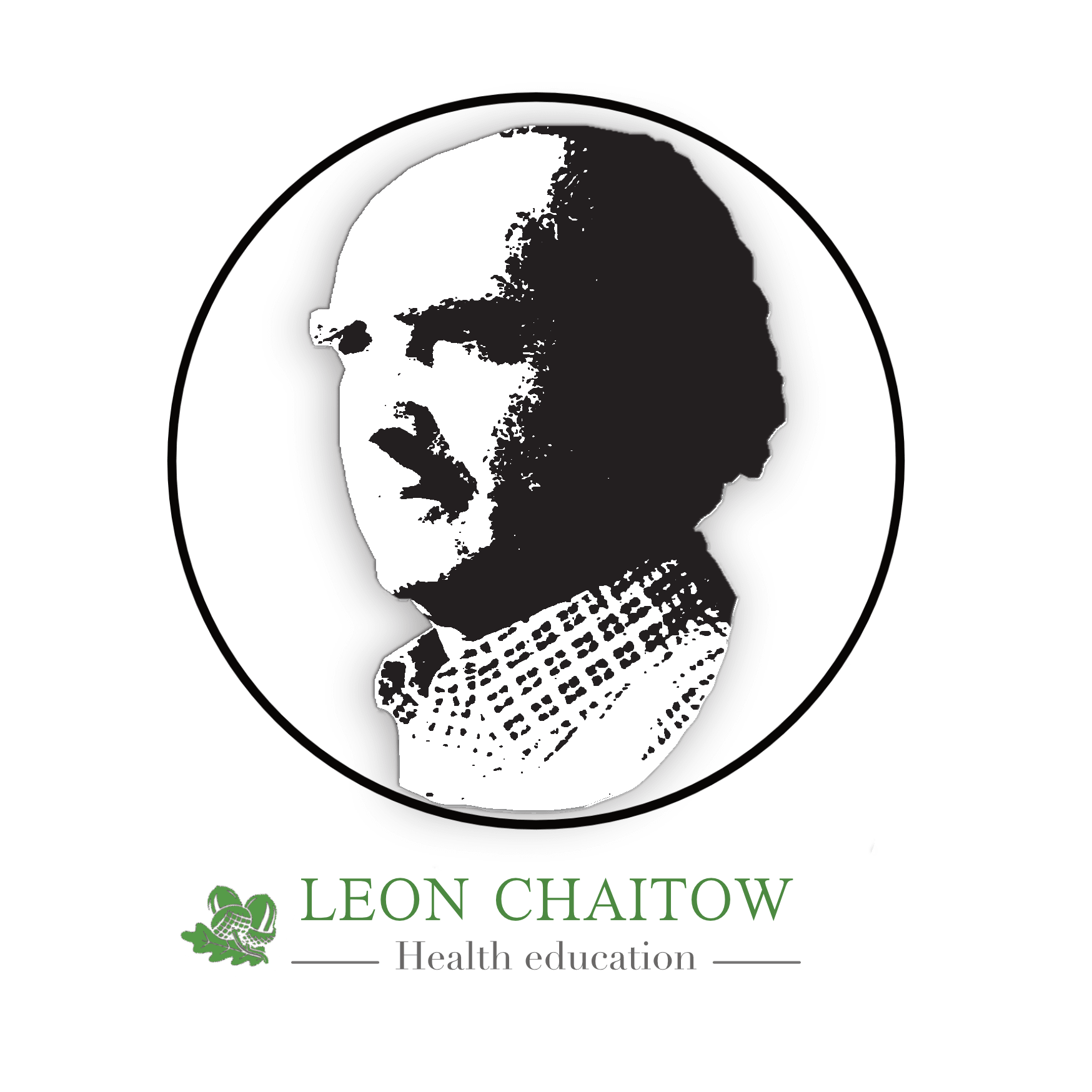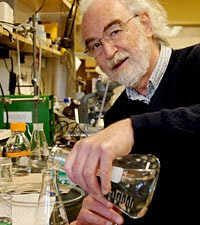Gerald Pollack in his lab (see below for more on this amazing researcher)
This posting leans heavily on a number of articles written over the past few years, for the online magazines NaturopathyDigest, and its’ sister publication MassageToday.
Articles include:
- The Amazing Fascial Web, Part I. May, 2005 (Vol. 05, Issue 05)
- The Amazing Fascial Web, Part II. June, 2005 (Vol. 05, Issue 06)
- Breathing Patterns, Connective Tissue and Soft-Shelled Eggs. October, 2005 (Vol. 05, Issue 10)
The 2nd International Fascia Research Congress is rapidly approaching (October 27 to 30, 2009). This is to be held at the Free University, Amsterdam and so it seemed appropriate to return to some of the fascinating advances touched on in the earlier articles.
Fascia Congress
On the first morning of the Congress (Tuesday 27 October) I will be moderating a panel that aims to demonstrate a number of modalities to those attending who are research scientists, many of whom have little or no experience in manual therapy. Approximately 800 delegates are anticipated, and it if the pattern seen at the First Fascia Research Congress (Harvard Medical School Conference Center, Boston, November 2007) is repeated, a little under half will be researchers with the other half practitioners and therapists from various clinical background.
The panel will comprise expert clinicians who will demonstrate and explain current thinking as to the mechanisms involved, Neurodynamics (‘neural flossing’) – demonstrated by Michel Coppieters PT; Vibrational methods – demonstrated by Zachary Comeaux DO; High velocity low amplitude manipulation (‘adjustment’) – demonstrated by Geoff Bove DC; Structural Integration (Rolfing) – demonstrated by Robert Schleip PhD; Connective Tissue Manipulation (or CT Massage) – demonstrated by Stephanie Prendergast PT; and Positional Release Techniques (e.g. Straincounterstrain) – – demonstrated by myself.
There will be both video demonstrations of the methods, as well explanations by the expert presenters – and critically – questions for researches regarding mechanisms – particularly those linked to fascia. Ample time will be allowed for questions from delegates.
It should be fascinating!
Fascia related topics in archived articles
In this short posting I’ve added details of a few fascinating new pieces of fascia related research, and some links to spice this up – and although not always immediately apparent – this topic and the associate research, reflects directly on the work of all manual therapists.
Some of the key fascia related topics covered in earlier articles were :
- The presence of contractile smooth muscle cells (SMCs)/myofibroblasts) that are embedded in most connective tissues. For example SMCs have been located widely in connective tissues including cartilage, ligaments, spinal discs and lumbodorsal fascia (Ahluwalia 2001, Hastreite et al 2001)
- The facts that the extracellular matrix (ECM) plays a key role in the transmission of forces generated by the organism (e.g. muscle contraction) or externally applied (e.g. gravity, or by means of manually appliedtherapy).
- Cell-matrix adhesion sites appear to host a ‘mechanosensory switch’ as they transmit forces from the ECM to the cytoskeleton, and vice versa, triggering internal signals following mechanical stimulation, such as occurs in manual therapy (Chen & Ingber 1999).
- There appear to be forms of communication within the fascial matrix, for example caused by tugging in the mucopolysaccharides, created by twisting acupuncture needles (Langevin et al 2005)
German researchers, Robert Schleip et al ( 2005), note that:
“The ability of fascia to contract is further demonstrated by the widespread existence of pathological fascial contractures. Probably, the most well known example is Dupuytren disease (palmar fibromatosis), which is known to be mediated by the proliferation and contractile activity of myofibroblasts. Lesser known is the existence of similar contractures in other fascial tissues which are also driven by contractile myofibroblasts, e.g. plantar fibromatosis, Peyronies disease (induratio penis plastica), club foot, or – much more commonly – in the frozen shoulder with its documented connective tissue contractures. Given the widespread existence of such strong pathological chronic contractures, it seems likely that minor degrees of fascial contractures might exist among normal, healthy people and have some influence on biomechanical behavior.”
Anyone using myofascial release approaches, or acupuncture, should be able to appreciate the potential therapeutic implications of these discoveries.
Research involving fascia and water’s amazing crystalline properties
And more recently, even more evidence has emerged of the mysteries of fascia.
For example:
The behavior of water that interacts with protein in the human body is becoming clearer. Professor Martin Gruebele of the University of Illinois explains:
“Water in our bodies has different physical properties from ordinary bulk water, because of the presence of proteins and other biomolecules. Proteins change the properties of water to perform particular tasks in different parts of our cells.”
He continued: “Water can be viewed as a ‘designer fluid’ in living cells.” For more on this topic click on this link
Sommer & Zhu (2008) note that interfascial water plays a key part in what is termed ‘protein folding’, the process necessary for cells to form their characteristic shapes – and that nano-crystals are a part of this process – and that these are influenced by light.
“In the course of a systematic exploration of interfacial water layers on solids we discovered microtornadoes, found a complementary explanation to the surface conductivity on hydrogenated diamond, and arrived at a practical method to repair elastin degeneration, using light.”
Leading researcher in this field, Pollack (2006), has shown that water can at times demonstrate a tendency to behave in a crystalline manner. He has discussed interfacial water in living cells known as vicinal water. Interfacial water exhibits structural organizations that differ from what is termed ‘bulk’ water. This ‘vicinal’ water seems to be influenced by structural properties that make up the cell. In discussion of one example of this, in relation to the water in a temperomandibular joint, Pollack says: “The combined data from three different methods lead to the conclusion that all or almost all of the water in the intact disc is bound water and does not have properties consistent with free or bulk water.”
Pollack also says:
“If you want to understand what happens in any system – be it biological, or physical, or chemical, or oceanographic, or atmospheric, or whatever – it doesn’t matter, anything involving water, you really have to know the behavior of this special kind of gel-like water, which dominates.”
Pollack’s water studies have led to amazing possibilities: that water acts as a battery, that this battery may recharge in a way resembling photosynthesis, that these water batteries could be harnessed to produce electricity. He discusses these ideas in a lecture now playing on UWTV: “Water, Energy and Life: Fresh Views From the Water’s Edge.”
For a fascinating insight into water research I suggest you download – or watch – this free video of Professor Pollack’s recent address at the University of Washington. To do so click on this link:
Fascia, water and manual therapy
Several years ago Klingler & Schleip (2004) showed that the water content of fascia partially determines its’ stiffness, and that stretching, or compression, of fascia (as occurs during almost all manual therapies, causes water to be extruded (like a sponge) – making the tissues more pliable and supple. After a while the water is taken up again and stiffness returns, but in the mean time structures can have been mobilised and stretched more effectively and comfortably, than were they still densely packed with water.
•Klingleret al measured wet & dry fresh human fascia, and found that during an isometric stretch, water is extruded, refilling during a subsequent rest period
•Aswater extrudes during stretching, temporary relaxation occurs in the longitudinal arrangement of the collagen fibers
•If the strain is moderate, and there are no micro-injuries, watersoaks backinto the tissue until it swells, becoming stifferthan before
All this suggests that much manual therapy, and the tissue responses experienced, may relate to sponge-like squeezing and refilling effects in the semi-liquidground substance, with its water binding glycosaminoglycans and proteoglycans.
Muscle energy technique-like contractions and stretches almost certainly have similar effects on the water content of connective tissue, as do myofascial release methods, and the multiple force-loading elements of massage.
The speed with which research is uncovering the secrets of fascia is mind-boggling, and I hope to see you in Amsterdam to discover even more!
REFERENCES
·Ahluwalia, S., 2001. Distribution of smooth muscle actin containing cells in the human meniscus. Journal of Orthopaedic Research 19 (4), 659–664.
·Born, B., Kim, S.J., Ebbinghaus, S., Gruebele, M., Havenith, M. 2008 The terahertz dance of water with the proteins: The effect of protein flexibility on the dynamical hydration shell of ubiquitinFaraday Discussions 141, pp. 161-173
·Hastreite, D., et al., 2001. Regional variations in certain cellular characteristics in human lumbar intervertebral discs, including the presence of smooth muscle actin. Journal of Orthopaedic Research 19 (4), 597–604.
·Klingler W Schleip R Zorn A 2004 European Fascia Research Project Report. 5th World Congress Low Back and Pelvic Pain, Melbourne, November 2004
·Langevin H Bouffard N Badger G et al 2005 Dynamic fibroblast cytoskeletal response to subcutaneous tissue stretch ex vivo and in vivo Am J Physiol Cell Physiol288:C747-756
·Pollack G et al 2006Water And The Cell.Springer
·Schleip R, Klingler W, Lehmann-Horn F 2005 Active fascial contractility: fascia may be able to contract in a smooth muscle-like manner and thereby influence musculoskeletal dynamics. Medical Hypotheses 65:273–277

